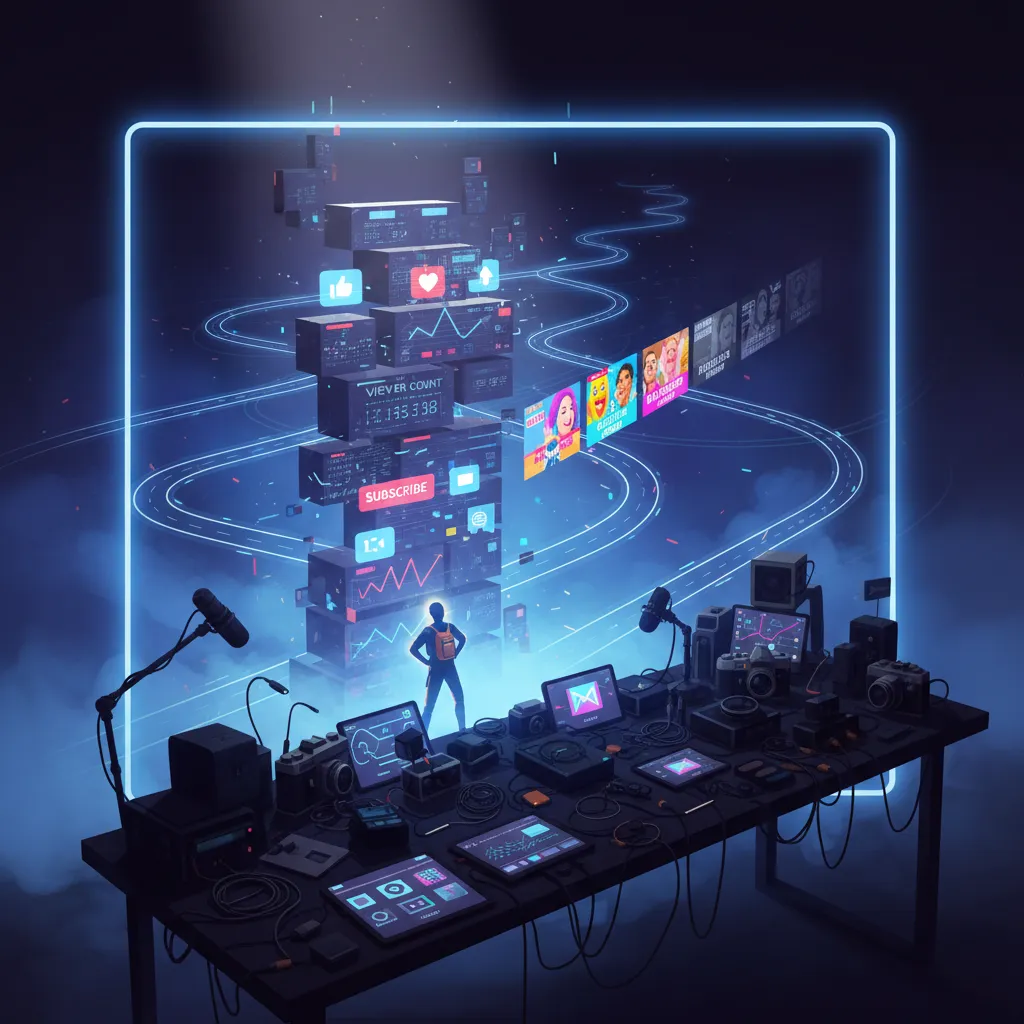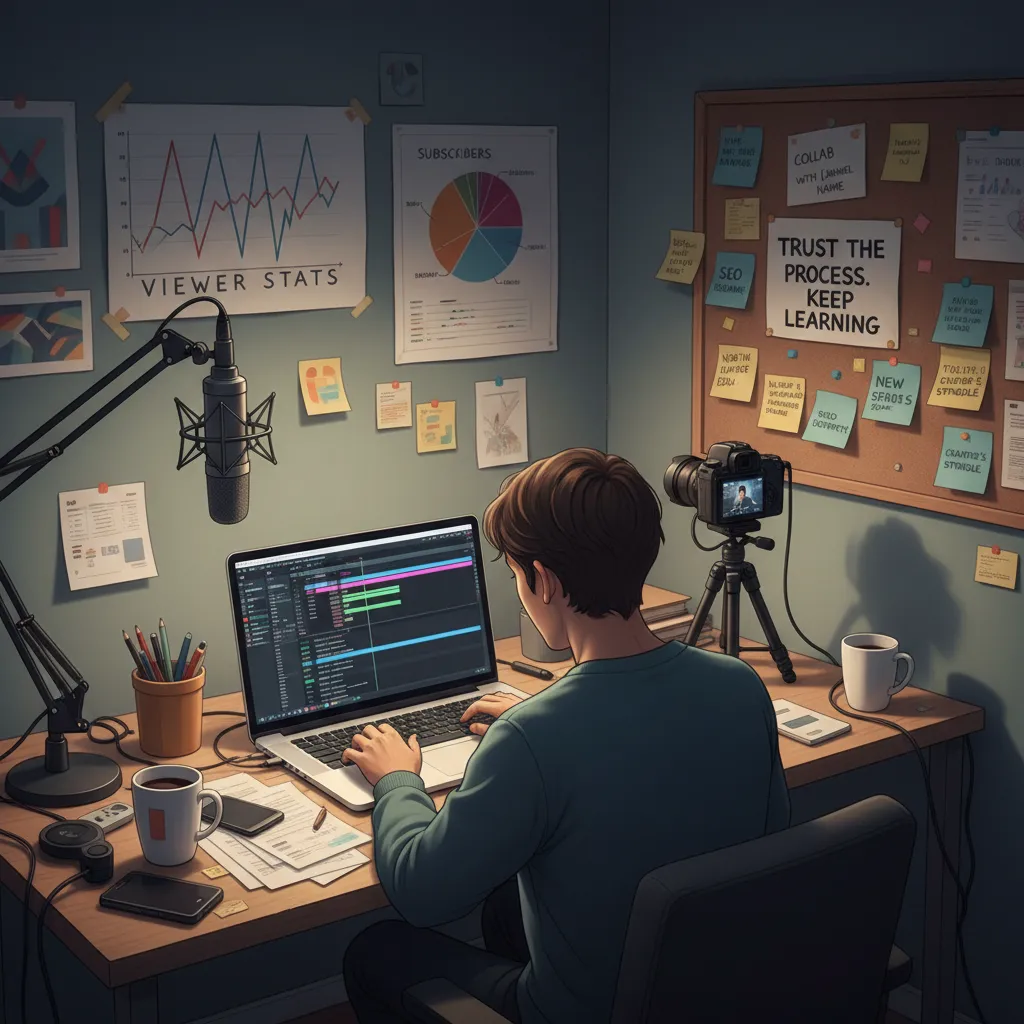Confession: I’ve woken up to another day of zero comments, flatlining view counts, and the haunting suspicion that YouTube’s algorithm must have it in for me. If you’re reading this, you’ve probably been there, too. But what if I told you it’s not about luck, and it’s (almost) never the algorithm’s fault? Truth be told, there’s a blueprint successful small channels are using right now—one that’s equal parts strategy, stubbornness, and a dash of creative chaos. Today, I’m inviting you behind the curtain to see how the game is really played.
Face the Uncomfortable Truth: Why Your Small Channel Isn’t Growing (Yet)
Let’s be honest: YouTube growth isn’t magic, and it’s definitely not just luck. If your small channel feels stuck—maybe at 20 views, maybe a few hundred—it’s time to face the uncomfortable truth. The real reason your channel isn’t growing (yet) is strategy. Or, more accurately, the lack of one.
“The missing piece is most likely strategy.”
Stop Blaming the Algorithm—Start Owning Your Strategy
It’s easy to point fingers at the YouTube algorithm, especially with all the talk about YouTube algorithm changes in 2025. But here’s the reality: the algorithm isn’t out to get you. In fact, it’s craving fresh, relevant, well-packaged content from small creators. The problem? Most creators fall into the “post and pray” trap—uploading videos with no real plan, hoping something will magically take off.
“A lot of people just post and pray.”
Common Pitfalls: Why Your Content Isn’t Catching On
- Lack of Focus: Are you making videos for everyone, or for a specific audience? Without clear niche targeting for YouTube creators, your channel blends into the noise.
- Scattershot Topics: Jumping from one topic to another confuses viewers and the algorithm. Consistency is key in YouTube growth strategies.
- Sleepy Thumbnails & Titles: If your packaging doesn’t grab attention, no one clicks—no matter how good your content is.
- Solving the Wrong Problem: Maybe your videos are helpful, but not for the people you want to reach. Or maybe you’re entertaining, but not in a way that stands out. Ouch.
Strategy Is Multifaceted—Here’s What You’re Missing
Think Media coaches see it all the time: creators stuck at 20 views suddenly jump to hundreds, and those at hundreds break into thousands. It’s not luck. It’s not a secret hack. It’s a shift in strategy, built on four pillars:
- Niche Focus: Who is your channel for? What specific problem do you solve? Dial in your audience and your message.
- Content Packaging: Thumbnails and titles aren’t afterthoughts—they’re your first impression. Make them count.
- Consistent Value: Every video should clearly deliver something—education, entertainment, or both. What’s the takeaway?
- Format Fit: Are you using the right video style for your message and your moment? Try vertical, podcast, faceless, or even drawing formats if your current approach isn’t working.
Rethink, Don’t Just Repeat
Here’s the hard truth: uploading more videos isn’t the answer if you’re repeating the same mistakes. Effective YouTube growth strategies in 2025 are about rethinking your niche, sharpening your value proposition, and packaging your content for real people—not just the algorithm. When you shift your focus from “more uploads” to “better strategy,” you’ll finally start to see the breakthrough you’ve been waiting for.

Idea Bootcamps, Bad Angles, and the Surprising Science of Content Packaging
Let’s get real: most of your content ideas will be… honestly, pretty bad. That’s not an insult—it’s a universal truth in content creation. Even the pros admit it. As one coach put it,
“Your ideas suck. Now, so do mine.”The difference between channels that break through and those that stall isn’t some magical creative spark. It’s the discipline of brainstorming, testing, and ruthlessly narrowing down ideas until you find the one worth making.
Content Creation Tips: The Bootcamp Approach
Think of brainstorming as your daily workout. Borrow a page from business thinkers like James Altucher and write 10 ideas a day. Don’t aim for perfection—aim for muscle memory. The first few ideas will be obvious or bland. Push yourself to get to 10, even if some are weird or silly. The point is to build your idea-generation muscles, so when a truly strong concept appears, you recognize it.
- Capture every idea, no matter how rough.
- Review and narrow down to the one or two that stand out.
- Remember:
“You want to be capturing a lot of ideas to narrow down to one strong idea.”
Angles: The Secret Ingredient for Breakout Videos
Here’s where most creators miss out: angles. If your video topic could double as everyone else’s, it’s time to go back to the drawing board. Ask yourself, “What’s a fresh, weird, or ultra-specific way into this topic?” For example, if you’re making a chicken coop video, don’t settle for “How to Build a Chicken Coop.” Instead, try “The $50 Chicken Coop That Survived a Blizzard” or “3 Chicken Coop Mistakes I Made (So You Don’t Have To).”
Brainstorming angles isn’t just about creativity—it’s about aligning with what viewers are actively searching for. Research shows that effective content packaging (including titles and thumbnails) can dramatically increase click-through and retention rates. The more unique and relevant your angle, the higher your chance of being discovered.
YouTube Thumbnail Optimization and Video Hooks: Not Afterthoughts
Here’s a hard truth: your thumbnail and title aren’t decorations you slap on at the end. They’re mission-critical parts of your big idea. The most successful creators spend 10 to 100 times more time on the topic, title, and thumbnail than you’d expect. Before you even hit record, ask yourself:
- Does my title make someone curious enough to click?
- Does my thumbnail visually tell the story or tease the payoff?
- Is my hook—the first 10 seconds—impossible to ignore?
Video Content Structure: Package It Like a Pro
Think of your topic, title, and thumbnail as a single package. They should work together to promise a clear, compelling benefit. For example, a CEO interview could become “How to Use YouTube for Business” or “CEO’s Secret to 500 Subscribers.” Each is a different angle, and each requires a different packaging strategy.
In the messy reality of YouTube growth, strong content starts with the discipline of brainstorming, the courage to discard bad ideas, and the science of packaging your best ones for maximum impact.

The Algorithm Isn’t Out to Get You—It Wants You To Win (If You Know the Rules)
Let’s clear up a myth: the YouTube algorithm isn’t your enemy. In fact, it’s designed to help you win—if you understand how it works. Right now, YouTube is facing a world of global view dips and rising competition. More creators are uploading than ever, and viewers’ attention is split between Shorts, long-form videos, and even platforms like Netflix and Hulu. But here’s the good news: YouTube is doubling down on small creators and discoverability. According to YouTube insiders like Rene Ritchie and Todd Bup prey, there’s a dedicated team making sure new channels have a real shot at breaking through.
Here’s the reality: YouTube’s algorithm changes in 2025 are all about interest media. That means your audience can find you before they ever subscribe. The days of obsessing over subscriber counts are fading. Now, niche targeting for YouTube creators and optimizing YouTube content around specific interests are the real growth levers. If someone watches a single video about vertical gardening, their homepage will soon be filled with similar content—even from channels with under 100 subscribers and just a handful of views. YouTube’s algorithm is looking at recent watch history and keywords more than ever before.
- Discoverability Push: YouTube is actively surfacing small channel videos—even those with 20 views—if they match a viewer’s interests.
- Interest Over Subscribers: The move to ‘interest media’ means your content can go viral with the right topic, regardless of your sub count.
- Algorithmic Focus: Watch history and keyword clarity now outweigh channel size. One click on a niche topic, and the algorithm floods viewers with related videos.
But here’s some tough love: the algorithm punishes aimless uploads. If you’re posting random content without a clear focus, you’ll get lost in the noise. On the flip side, creators who dive deep into keywords and specific interests are getting rewarded. It’s not about uploading more—it’s about uploading smarter. As one expert put it,
“The algorithm is more often than not waiting for you to get your act together.”
Real-time coaching and analytics-driven adaptation are now your superpowers. It’s not enough to know basic SEO tricks. You need to study your analytics, adapt your content, and respond to what your audience is actually watching. This is how breakout channels are born—like the new creator who posts three videos and sees 33,000 views on their third, while others with 300 uploads remain stuck at 30 views. The difference? Storytelling, structure, packaging, and niche clarity.
Remember, YouTube’s own team says,
“They actually are rigging the game in your favor and not against you.”The platform’s 2.7 billion projected users in 2025 are hungry for content that matches their interests. If you know the rules—niche targeting, optimizing YouTube content, and engaging your audience—the algorithm is ready to help you win.

Conclusion: The Perfect Video Recipe—It’s Messier, But More Attainable Than You Think
If you’ve ever stared at your YouTube dashboard, wondering why your views have flatlined, you’re not alone. The journey from stagnant growth to breakthrough is rarely a straight line. It’s easy to blame the algorithm, but the real secret to YouTube growth isn’t a mystery—it’s a messy, hands-on process that’s more attainable than you might think.
Let’s be honest: every creator, even the ones you admire, has stumbled through awkward pivots, reworked their niche, and experimented with endless packaging tweaks. The path to growth is paved with deliberate strategy, not luck. The most effective YouTube growth strategies come from creators who are willing to get their hands dirty—testing new ideas, learning from analytics, and listening to coaching feedback. It’s not about waiting for a viral miracle; it’s about building your own momentum, one upload at a time.
Here’s the truth: the perfect video recipe isn’t a neat checklist. It’s a blend of strategy, creativity, and relentless adaptation. You’ll need to rethink your titles, sharpen your thumbnails, and sometimes even reframe your entire channel focus. This is where content creation tips really matter. The creators who break through aren’t just lucky—they’re curious, persistent, and willing to challenge what’s not working. They embrace the messiness, knowing that every failed experiment is a step closer to the video that finally clicks.
Don’t underestimate the power of a single, specific idea. Sometimes, all it takes is one video—crafted with a sharp hook and a compelling package—to ignite your channel’s growth. Even in a crowded niche or during a slow season, a well-optimized upload can defy the odds. As you refine your approach, remember:
'Your next upload could be the one that changes everything.'This isn’t just motivational fluff; it’s a reality proven by countless small creators who went from obscurity to rapid growth with one breakthrough moment.
What sets these creators apart? They combine coaching feedback, analytics, and creative persistence. They don’t let industry downturns or algorithm changes stop them. Instead, they double down on optimizing YouTube content—studying what works, learning from their audience, and never settling for stale ideas. Human quirks, curiosity, and a willingness to adapt are the wild cards that often lead to unexpected success.
So, if you’re feeling stuck, remember: the perfect video recipe is within reach, but it’s going to get a little messy. Embrace the trial and error. Lean into strategy, not luck. And above all, keep creating—because your next upload might just be the one that changes everything.
TL;DR: Small YouTube channels can break out—even when global views are down—by swapping blind luck for real strategy. Focus on niche clarity, irresistible ideas, sharp packaging, and understanding what the algorithm genuinely wants. The “perfect video recipe” isn’t a myth—it’s within your reach, quirks and all.



